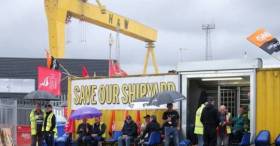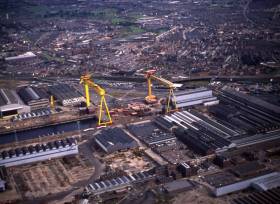Displaying items by tag: Harland & Wolf
Saved Shipyard: Harland & Wolff in £6m Deal with InfraStrata
The Belfast shipyard that built the Titanic, Harland and Wolff is according to the Sunday Times, set to be rescued tomorrow in a £6m deal.
AIM-listed company, InfraStrata has agreed to buy the historic shipyard out of administration, will tap investors for the money tomorrow via a share placing. It is understood to have signed a conditional contract to buy Harland and Wolff from administrator BDO.
InfraStrata will use the shipyard to supply a £265m gas storage facility it is building north of the city, preserving the jobs of the 79 remaining workers.
Harland and Wolff, which employed 30,000 people in Belfast’s industrial heyday, fell into administration in August after its Norwegian parent company, Dolphin Drilling, failed to find a buyer.
For more to read, click here.
Shipyard: Hopes Rising for Breakthrough at Harland & Wolff
According to the News Letter, hopes that the troubled shipyard of Harland & Wolff can be rescued were rising (yesterday) after a weekend of intensive negotiations.
The iconic company based in Belfast Lough entered administration last month after its Norwegian parent company, Dolphin Drilling, failed to find a buyer.
Spurred on by support from the public, the remaining workers staged a round-the-clock occupation of the site as part of a high-profile campaign to save the yard.
They have also maintained pressure on the government in the hope that the business could be nationalised.
Click here for more on the story.
Workers at Harland & Wolff have seen a deluge of support - from donations of suncream and food to performances by local celebrities.
As the Belfast Telegraph reports, the workforce continue their occupation of the historic shipyard even as the firm is placed into administration, there has been a steady stream of supporters arriving with donations and words of encouragement.
Newry singer Tommy Sands donned a Harland & Wolff cap as he performed a number of songs at the gates of the shipyard yesterday, including one he had written for the workers.
Unite shop steward and Harland & Wolff steel worker Joe Passmore thanked Mr Sands, saying his performance had made the hairs on the back of his neck stand up.
"Fantastic, I'm sure every shipyard worker here had the same feeling, I know you did actually," he said.
More can be read here on the story of the shipyard which as previously reported drew calls for it to be nationalised.
Leaders from trade unions in the North are appealing to the new UK prime minister Boris Johnson to nationalise Belfast’s historic Harland & Wolff shipyard to save it from closure.
As The Irish Times reports, unions have warned the yard, where the Titanic was built, is just “hours and days” from closing its doors and is struggling to find a buyer.
Susan Fitzgerald, Unite’s regional coordinating officer, said Mr Johnson should step up to save jobs and the shipyard, whose giant cranes dominate the Belfast sky line, but which currently has no contracts. The operation, whose majority Norwegian owner filed for bankruptcy in June, has been in existence for 158 years.
Ms Fitzgerald said: “Harland & Wolff – with the world’s sixth-largest dry dock – is facing insolvency next week. If that happens, the skills of the workers, as well as the yard’s infrastructure, will be lost, diminishing the economy’s potential now and into the future.
More on the story can be read here.
Second Stena ‘Superfast’ Ferry is Underway from Poland
The new route to Loch Ryan Port, Cairnryan includes a new £80m ferryport terminal which will be served by the 30,000 gross tonnes sisters, the largest ever ferries on the North Channel. Stena Superfast VIII is currently in the Skagerrak off northern Denmark and follows her sister Stena Superfast VII which arrived over the weekend, having also undergone refurbishment at the Romentowa shipyard.
The relocation of Scottish terminal from Stranraer to Loch Ryan Port is seven miles closer to the open sea and sailing times are to be reduced to 2hrs and 15minutes. The new terminal is to be officially opened on 25th November when First Minister of Scotland Alex Salmond and Deputy First Minister of Northern Ireland Martin McGuinness will join Dan Sten Olsson, Chairman of Stena Line.
As for the 15,229 gross tonnes Stena Navigator, she made her Stranraer-Belfast sailing yesterday, after de-storing at the VT4 ferry terminal, only completed in 2008, she proceeded to berth at Albert Quay, the location of the former city-centre ferry terminal.
In the interim period to the opening of the new Belfast-Cairnryan route, the sailing schedule on the Belfast-Stranraer service are been maintained by another conventional ferry, Stena Caledonia and fast sailings by the HSS Stena Voyager.
HSS Stena Voyager is expected to lay-up at VT4 after making final sailings to and from Stranraer this Sunday. It is expected Stena Caledonia will also be withdrawn that day and berth at Albert Quay. In the process she will pass Harland & Wolf shipyard, where she was launched in 1981 as the St. David, the last of the quartet of Saint-class ferries commissioend for Sealink/British Rail.
The career of Stena Navigator on the North Channel was short as she only entered service two years ago. She was built in 1984 as Champs Elysees first served for SNCF/Sealink's jointly run Dover-Calais route, followed by a brief spell under Stena Line as Stena Parisien on Newhaven-Dieppe sailings.
She returned to the Straits of Dover route but this time as SeaFrance Manet under the control of SeaFrance. In 2008 SeaFrance introduced SeaFrance Moliere, the former Superfast X, ironically another sister of Stena Line's 'Superfast' ships. This Superfast vessel along with two custom built newbuilds entered SeaFrance service in recent years which led to the eventual replacement of SeaFrance Renoir and her half sister SeaFrance Manet.
- Port of Belfast
- Stena Line
- Ports and Shipping News
- Ferry news
- Loch Ryan Port
- HSS Stena Voyager
- St. David
- SeaFrance
- DoverCalais
- Belfast Lough News
- Sealink
- H&W
- BelfastCairnryan
- Stena Superfast sisters
- Loch Ryan Port Cairnryan
- Romentowa
- Harland & Wolf
- Sealink/British Rail
- SaintClass sisters
- SNCF
- Straits of Dover
- Attica
- VT4 Terminal
- Loch Ryan Scotland
- Sealink British Rail

































































